Hydrological Analysis of Extreme Rain Events in a Medium-Sized Basin
Abstract
:1. Introduction
2. Materials and Methods
2.1. Study Area: Humber River Basin
2.2. Precipitation Data
2.3. Hydrological Model HEC-HMS, Setup, and Methods
2.4. Hydrological Model HBV-Light, Setup and Methods
3. Results
4. Discussion
5. Conclusions
Author Contributions
Funding
Institutional Review Board Statement
Informed Consent Statement
Data Availability Statement
Acknowledgments
Conflicts of Interest
References
- Nirupama, N.; Armenakis, C.; Montpetit, M. Is flooding in Toronto a concern? Nat. Hazards 2014, 72, 1259–1264. [Google Scholar] [CrossRef]
- Yang, Y.; Gan, T.Y.; Tan, X. Spatiotemporal Changes in Precipitation Extremes over Canada and Their Teleconnections to Large-Scale Climate Patterns. J. Hydrometeorol. 2019, 20, 275–296. [Google Scholar] [CrossRef]
- Tan, X.; Gan, T.Y.; Chen, Y.D. Synoptic moisture pathways associated with mean and extreme precipitation over Canada for summer and fall. Clim. Dyn. 2019, 52, 2959–2979. [Google Scholar] [CrossRef]
- Wazneh, H.; Arain, M.A.; Coulibaly, P. Historical Spatial and Temporal Climate Trends in Southern Ontario, Canada. J. Appl. Meteorol. Climatol. 2017, 56, 2767–2787. [Google Scholar] [CrossRef]
- Soulis, E.D.; Sarhadi, A.; Tinel, M.; Suthar, M. Extreme precipitation time trends in Ontario, 1960–2010. Hydrol. Process. 2016, 30, 4090–4100. [Google Scholar] [CrossRef]
- Rudra, R.P.; Dickinson, W.T.; Ahmed, S.I.; Patel, P.; Zhou, J.; Gharabaghi, B.; Khan, A.A. Changes in Rainfall Extremes in Ontario. Int. J. Environ. Res. 2015, 9, 1117–1126. [Google Scholar] [CrossRef]
- Paixao, E.; Mirza, M.M.Q.; Shephard, M.W.; Auld, H.; Klaassen, J.; Smith, G. An integrated approach for identifying homogeneous regions of extreme rainfall events and estimating IDF curves in Southern Ontario, Canada: Incorporating radar observations. J. Hydrol. 2015, 528, 734–750. [Google Scholar] [CrossRef]
- Wijayarathne, D.; Boodoo, S.; Coulibaly, P.; Sills, D. Evaluation of Radar Quantitative Precipitation Estimates (QPEs) as an Input of Hydrological Models for Hydrometeorological Applications. J. Hydrometeorol. 2020, 21, 1847–1864. [Google Scholar] [CrossRef]
- Dibike, Y.B.; Coulibaly, P. Hydrologic impact of climate change in the Saguenay watershed: Comparison of downscaling methods and hydrologic models. J. Hydrol. 2005, 307, 145–163. [Google Scholar] [CrossRef]
- Cheng, C.S.; Li, Q.; Li, G.; Auld, H. Possible Impacts of Climate Change on Daily Streamflow and Extremes at Local Scale in Ontario, Canada. Part II: Future Projection. Atmos. Clim. Sci. 2012, 2, 427–440. [Google Scholar] [CrossRef] [Green Version]
- Ahmed, S.; Tsanis, I. Watershed Response to Bias-Corrected Improved Skilled Precipitation and Temperature under Future Climate—A Case Study on Spencer Creek Watershed, Ontario, Canada. Hydrol. Curr. Res. 2016, 7, 246. [Google Scholar] [CrossRef] [Green Version]
- Deng, Z.; Qiu, X.; Liu, J.; Madras, N.; Wang, X.; Zhu, H. Trend in frequency of extreme precipitation events over Ontario from ensembles of multiple GCMs. Clim. Dyn. 2016, 46, 2909–2921. [Google Scholar] [CrossRef]
- Muhammad, A.; Stadnyk, T.A.; Unduche, F.; Coulibaly, P. Multi-Model Approaches for Improving Seasonal Ensemble Streamflow Prediction Scheme with Various Statistical Post-Processing Techniques in the Canadian Prairie Region. Water 2018, 10, 1604. [Google Scholar] [CrossRef] [Green Version]
- Han, S.; Coulibaly, P.; Biondi, D. Assessing Hydrologic Uncertainty Processor Performance for Flood Forecasting in a Semiurban Watershed. J. Hydrol. Eng. 2019, 24, 05019025. [Google Scholar] [CrossRef]
- Leach, J.M.; Kornelsen, K.C.; Coulibaly, P. Assimilation of near-real time data products into models of an urban basin. J. Hydrol. 2018, 563, 51–64. [Google Scholar] [CrossRef]
- Awol, F.S.; Coulibaly, P.; Tsanis, I. Identification of Combined Hydrological Models and Numerical Weather Predictions for Enhanced Flood Forecasting in a Semiurban Watershed. J. Hydrol. Eng. 2021, 26, 04020057. [Google Scholar] [CrossRef]
- Golmohammadi, G.; Rudra, R.; Dickinson, T.; Goel, P.; Veliz, M. Predicting the temporal variation of flow contributing areas using SWAT. J. Hydrol. 2017, 547, 375–386. [Google Scholar] [CrossRef]
- Dong, F.; Neumann, A.; Kim, D.-K.; Huang, J.; Arhonditsis, G.B. A season-specific, multi-site calibration strategy to study the hydrological cycle and the impact of extreme-flow events along an urban-to-agricultural gradient. Ecol. Inform. 2019, 54, 100993. [Google Scholar] [CrossRef]
- Chapi, K.; Rudra, R.P.; Ahmed, S.I.; Khan, A.A.; Gharabaghi, B.; Dickinson, W.T.; Goel, P.K. Spatial-Temporal Dynamics of Runoff Generation Areas in a Small Agricultural Watershed in Southern Ontario. J. Water Resour. Prot. 2015, 7, 14–40. [Google Scholar] [CrossRef] [Green Version]
- Trudeau, M.P.; Richardson, M. Empirical assessment of effects of urbanization on event flow hydrology in watersheds of Canada’s Great Lakes-St Lawrence basin. J. Hydrol. 2016, 541, 1456–1474. [Google Scholar] [CrossRef]
- Kaykhosravi, S.; Khan, U.T.; Jadidi, M.A. The Effect of Climate Change and Urbanization on the Demand for Low Impact Development for Three Canadian Cities. Water 2020, 12, 1280. [Google Scholar] [CrossRef]
- Golmohammadi, G.; Prasher, S.; Madani, A.; Rudra, R. Evaluating Three Hydrological Distributed Watershed Models: MIKE-SHE, APEX, SWAT. Hydrology 2014, 1, 20–39. [Google Scholar] [CrossRef] [Green Version]
- Darbandsari, P.; Coulibaly, P. Inter-comparison of lumped hydrological models in data-scarce watersheds using different precipitation forcing data sets: Case study of Northern Ontario, Canada. J. Hydrol. Reg. Stud. 2020, 31, 100730. [Google Scholar] [CrossRef]
- Unduche, F.; Tolossa, H.; Senbeta, D.; Zhu, E. Evaluation of four hydrological models for operational flood forecasting in a Canadian Prairie watershed. Hydrol. Sci. J. 2018, 63, 1133–1149. [Google Scholar] [CrossRef] [Green Version]
- Sahraei, S.; Asadzadeh, M.; Unduche, F. Signature-based multi-modelling and multi-objective calibration of hydrologic models: Application in flood forecasting for Canadian Prairies. J. Hydrol. 2020, 588, 125095. [Google Scholar] [CrossRef]
- Haghnegahdar, A.; Tolson, B.A.; Craig, J.R.; Paya, K.T. Assessing the performance of a semi-distributed hydrological model under various watershed discretization schemes. Hydrol. Process. 2015, 29, 4018–4031. [Google Scholar] [CrossRef]
- Daggupati, P.; Shukla, R.; Mekonnen, B.; Rudra, R.; Biswas, A.; Goel, P.K.; Prasher, S.; Yang, W. Hydrological Responses to Various Land Use, Soil and Weather Inputs in Northern Lake Erie Basin in Canada. Water 2018, 10, 222. [Google Scholar] [CrossRef] [Green Version]
- Ontario Ministry of Natural Resources. Provincial Digital Elevation Model. 2013. Available online: https://library.carleton.ca/find/gis/geospatial-data/provincial-digital-elevation-model (accessed on 27 May 2019).
- TRCA. Humber River Watershed Scenario Modelling and Analysis Report; Toronto and Region Conservation Authority: Toronto, ON, Canada, 2008. [Google Scholar]
- Toronto and Region Conservation Authority. Open Data and Information. 2020. Available online: https://trca.ca/about/open/ (accessed on 19 December 2019).
- Government of Canada. Environment and Climate Change Canada. 2020. Available online: https://www.canada.ca/en/environment-climate-change.html (accessed on 23 June 2020).
- Government of Canada, Agriculture and Agri-food Canada. Land Use 1990, 2000 & 2010. Available online: https://open.canada.ca/data/en/dataset/18e3ef1a-497c-40c6-8326-aac1a34a0dec (accessed on 18 December 2019).
- CIVICA and TRCA. Final Report Humber River Hydrology Update; TRC14-004; Toronto and Region Conservation for the Living City: Toronto, ON, Canada, 2015. [Google Scholar]
- TRCA. Humber River State of the Watershed Report—Land and Resource Use; Toronto and Region Conservation for the Living City: Toronto, ON, Canada, 2008. [Google Scholar]
- Government of Canada, Canadian Soil Information Service. National Soil Database (NSDB): Detailed Soil Survey (DSS) Compilations. 2014. Available online: http://sis.agr.gc.ca/cansis/nsdb/dss/v3/index.html (accessed on 11 May 2020).
- Government of Canada, Agriculture and Agri-Food Canada. Ontario Detailed Soil Survey. 2015. Available online: https://open.canada.ca/data/en/dataset/a75c3d6c-354d-436d-999d-431fb3a9de79 (accessed on 11 May 2020).
- United States Department of Agriculture. Engineering Hydrology Training Series, Module 104: Runoff Curve Number Computations; Soil Conservation Service: Washington, DC, USA, 1989. [Google Scholar]
- Scharffenberg, W. Hydrologic Modeling System HEC-HMS User’s Manual; CPD-74A, Version 4.2; U.S. Army Corps of Engineers, Hydrologic Engineering Center: Davis, CA, USA, 2016. [Google Scholar]
- Feldman, A.D. Hydrologic Modeling System HEC-HMS Technical Reference Manual; CPD-74B; U.S. Army Corps of Engineers, Hydrologic Engineering Center: Davis, CA, USA, 2000. [Google Scholar]
- Washington State Department of Transportation. Highway Runoff Manual; M 31-16.05; Engineering and Regional Operations: Washington, DC, USA, 2019. [Google Scholar]
- Chow, V.T.; Maidment, D.R.; Mays, L.W. Applied Hydrology; McGraw-Hill: New York, NY, USA, 1988; ISBN 0 07-010810-2. [Google Scholar]
- Dougherty, M.; Dymond, R.L.; Goetz, S.J.; Jantz, C.A.; Goulet, N. Evaluation of Impervious Surface Estimates in a Rapidly Urbanizing Watershed. Photogramm. Eng. Remote Sens. 2004, 70, 1275–1284. [Google Scholar] [CrossRef] [Green Version]
- Rose, A.; Wilson, J.E.; Lavkulich, L.M. Analysis of Impervious Surface Area, and the Impacts on Soil-Based Agriculture and the Hydrologic Cycle: A Case Study in the Agricultural Land Reserve in Metro Vancouver, British Columbia, Canada. Agric. Sci. 2017, 8, 837–856. [Google Scholar] [CrossRef] [Green Version]
- Guthrie, R.; Deniseger, J. Impervious Surfaces in French Creek; Ministry of Water, Land and Air Protection: Vancouver Island, BC, Canada, 2001. [Google Scholar]
- United States Department of Agriculture. National Engineering Handbook, Chapter 15: Time of Concentration; 210-VI-NEH; Natural Resources Conservation Service: Washington, DC, USA, 2010. [Google Scholar]
- U.S. Army Corps of Engineers. Flood-Runoff Analysis Engineer Manual; EM 1110-2-1417; Engineering and Design: Washington, DC, USA, 1994. [Google Scholar]
- Simas, M.J.; Hawkins, R.H. Lag Time Characteristics in Small Watersheds in the United States. In Proceedings of the Second Federal Interagency Hydrologic Modeling Conference, ASCE, Las Vegas, NV, USA, 28 July–1 August 2002. [Google Scholar]
- Fang, X.; Cleveland, T.; Garcia, C.A.; Thompson, D.; Malla, R. Literature Review on Timing Parameters for Hydrographs; Report 0-4696-1, Project Number 0-4696; Department of Civil Engineering, Lamar University: Beaumont, TX, USA, 2005. [Google Scholar]
- Johnstone, D.; Cross, W.P. Elements of Applied Hydrology, 1st ed; Ronald Press: New York, NY, USA, 1949. [Google Scholar]
- Williams, G.B. Flood Discharge and the Dimensions of Spillways in India. Engineering (London) 1922, 134, 321–322. [Google Scholar]
- Carter, R.W. Magnitude and frequency of floods in suburban areas. US Geol. Surv. Prof. Pap. 1961, 424, 9–11. [Google Scholar]
- Pilgrim, D.H.; Cordery, I. Flood runoff. In Handbook of Hydrology; Maidment, D.R., Ed.; McGraw-Hill: New York, NY, USA, 1993. [Google Scholar]
- Perumal, M. Hydrodynamic derivation of a variable parameter Muskingum method: 2. Verification. Hydrol. Sci. J. 1994, 39, 443–458. [Google Scholar] [CrossRef]
- Seibert, J.; Vis, M.J.P. Teaching hydrological modeling with a user-friendly catchment-runoff-model software package. Hydrol. Earth Syst. Sci. 2012, 16, 3315–3325. [Google Scholar] [CrossRef] [Green Version]
- Bergström, S. Development and Application of a Conceptual Runoff Model for Scandinavian Catchments; SMHI Report RHO 7; Swedish Meteorological and Hydrological Institute: Norrköping, Sweden, 1976. [Google Scholar]
- Bergström, S. The HBV Model: Its Structure and Applications; SMHI Reports Hydrology No. 4; Swedish Meteorological and Hydrological Institute: Norrköping, Sweden, 1992. [Google Scholar]
- Steele-Dunne, S.; Lynch, P.; McGrath, R.; Semmler, T.; Wang, S.; Hanafin, J.; Nolan, P. The impacts of climate change on hydrology in Ireland. J. Hydrol. 2008, 356, 28–45. [Google Scholar] [CrossRef]
- Radchenko, I.; Breuer, L.; Forkutsa, I.; Frede, H.-G. Simulating Water Resource Availability under Data Scarcity—A Case Study for the Ferghana Valley (Central Asia). Water 2014, 6, 3270–3299. [Google Scholar] [CrossRef] [Green Version]
- Finger, D.; Vis, M.; Huss, M.; Seibert, J. The value of multiple data set calibration versus model complexity for improving the performance of hydrological models in mountain catchments. Water Resour. Res. 2015, 51, 1939–1958. [Google Scholar] [CrossRef]
- Westerberg, I.K.; Birkel, C. Observational uncertainties in hypothesis testing: Investigating the hydrological functioning of a tropical catchment. Hydrol. Process. 2015, 29, 4863–4879. [Google Scholar] [CrossRef]
- Poméon, T.; Jackisch, D.; Diekkrüger, B. Evaluating the performance of remotely sensed and reanalysed precipitation data over West Africa using HBV light. J. Hydrol. 2017, 547, 222–235. [Google Scholar] [CrossRef]
- Sucozhañay, A.; Célleri, R. Impact of Rain Gauges Distribution on the Runoff Simulation of a Small Mountain Catchment in Southern Ecuador. Water 2018, 10, 1169. [Google Scholar] [CrossRef] [Green Version]
- Seibert, J. HBV light version 2 User’s Manual. 2005. Available online: https://www.geo.uzh.ch/dam/jcr:c8afa73c-ac90-478e-a8c7-929eed7b1b62/HBV_manual_2005.pdf (accessed on 20 November 2020).
- Delidjakova, K.; Bello, R.; MacMillan, G. Measurement of Evapotranspiration Across Different Land Cover Types in the Greater Toronto Area; Sustainable Technologies Evaluation Program, Toronto and Region Conservation Authority: Toronto, ON, Canada, 2014. [Google Scholar]
- Nash, J.E.; Sutcliffe, J.V. River flow forecasting through conceptual models part I—A discussion of principles. J. Hydrol. 1970, 10, 282–290. [Google Scholar] [CrossRef]
- Awol, F.S.; Coulibaly, P.; Tolson, B.A. Event-based model calibration approaches for selecting representative distributed parameters in semi-urban watersheds. Adv. Water Resour. 2018, 118, 12–27. [Google Scholar] [CrossRef]
- Wijayarathne, D.; Coulibaly, P.; Boodoo, S.; Sills, D. Evaluation of Radar-Gauge Merging Techniques to Be Used in Operational Flood Forecasting in Urban Watersheds. Water 2020, 12, 1494. [Google Scholar] [CrossRef]
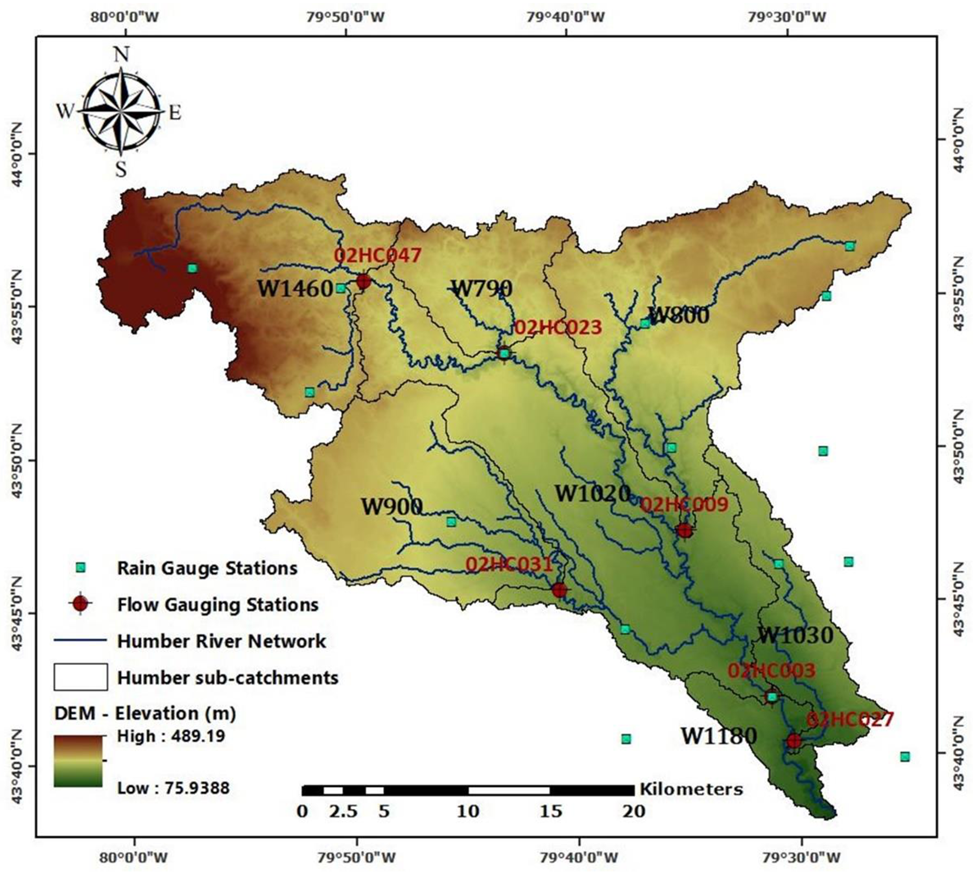

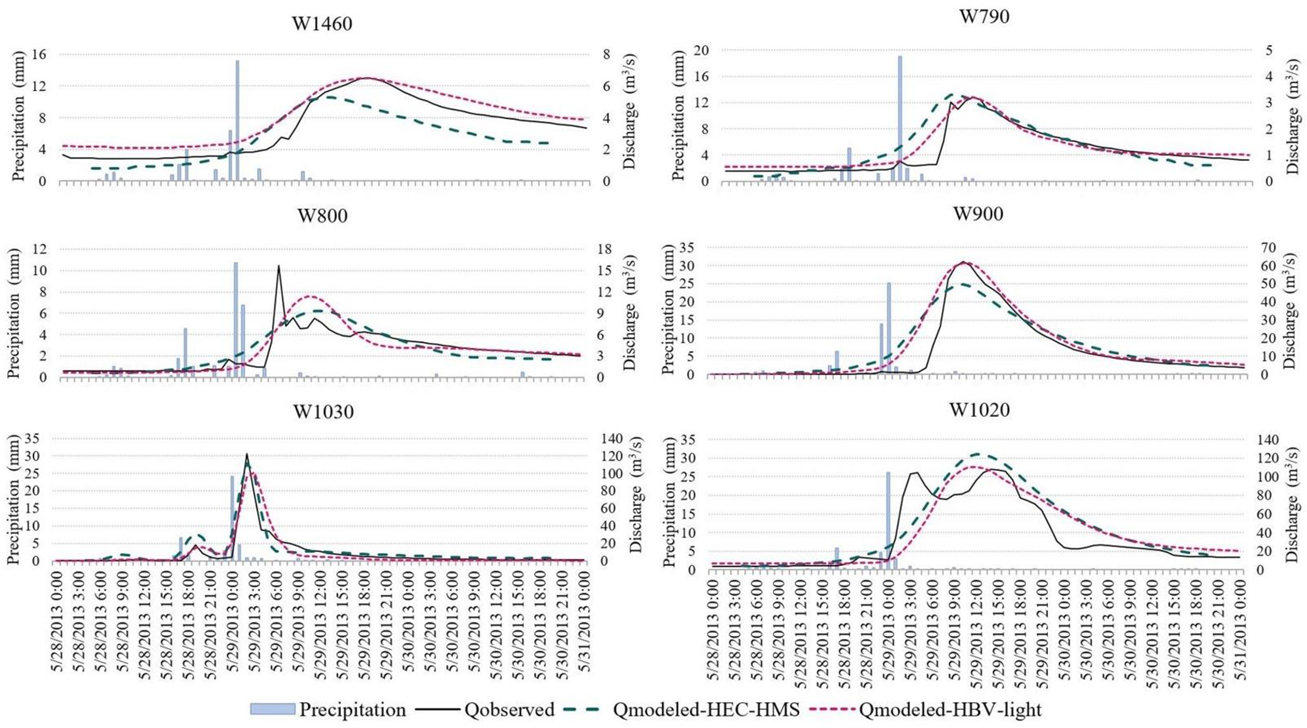
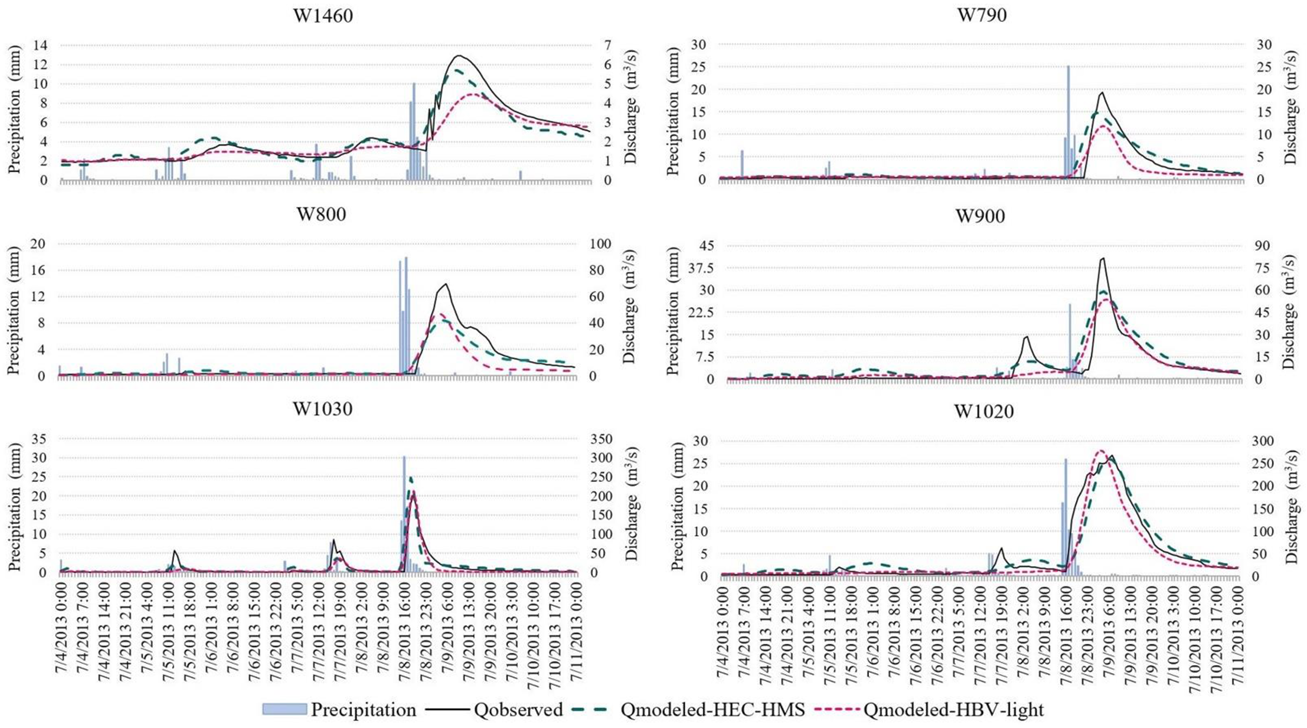
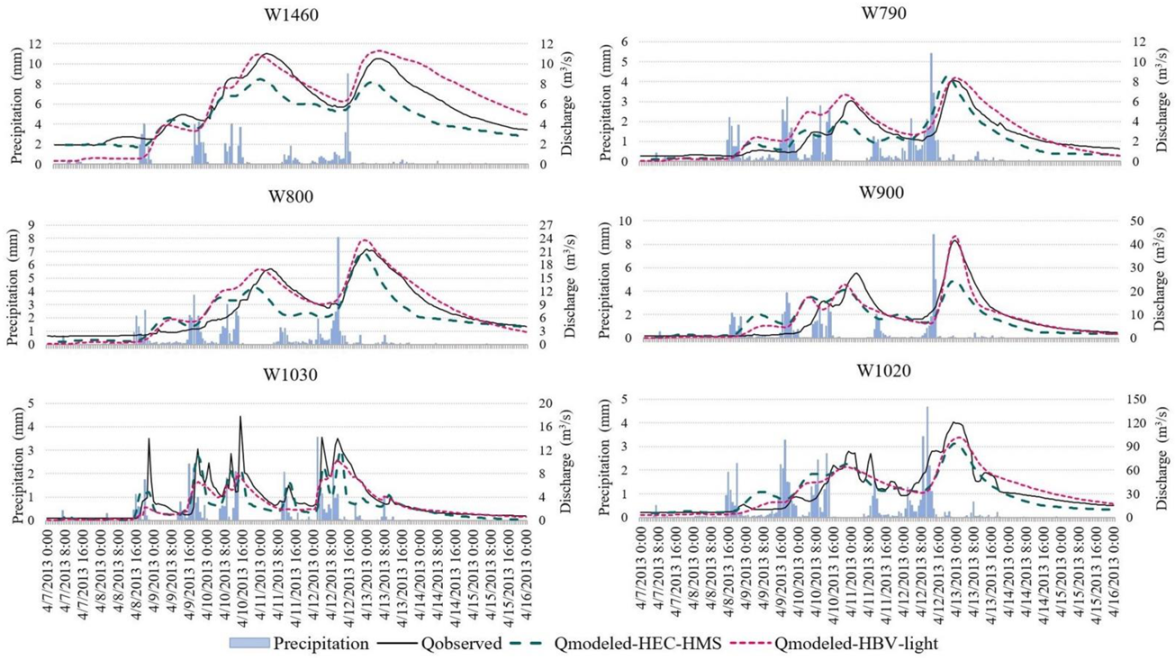
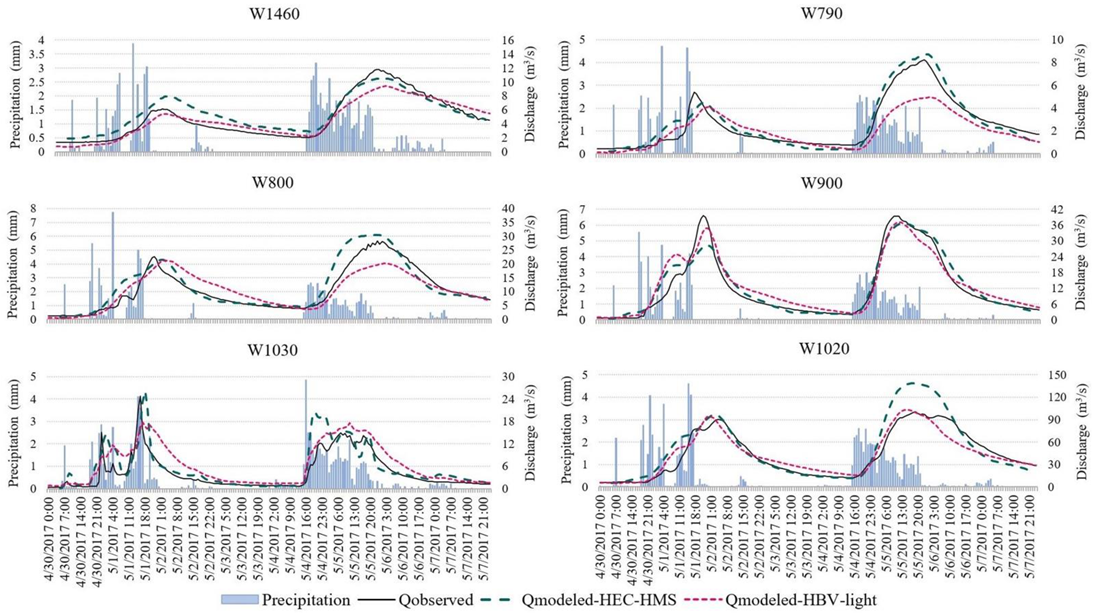
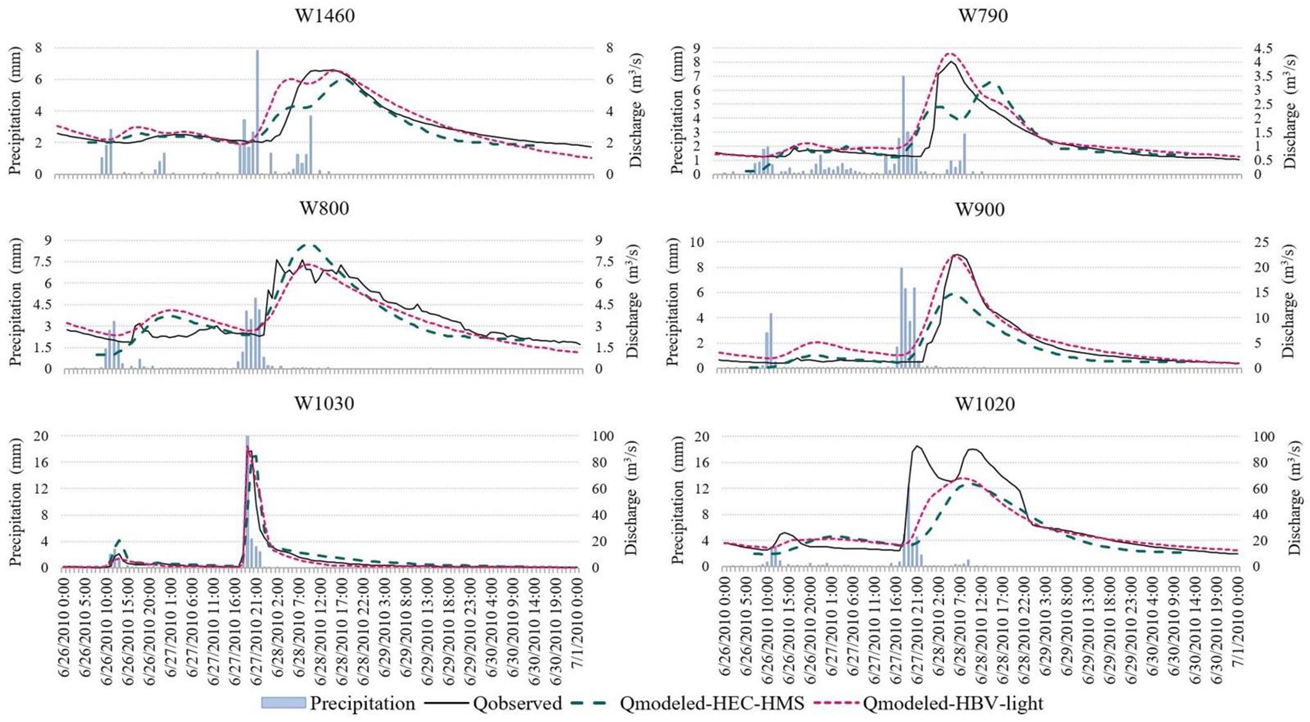
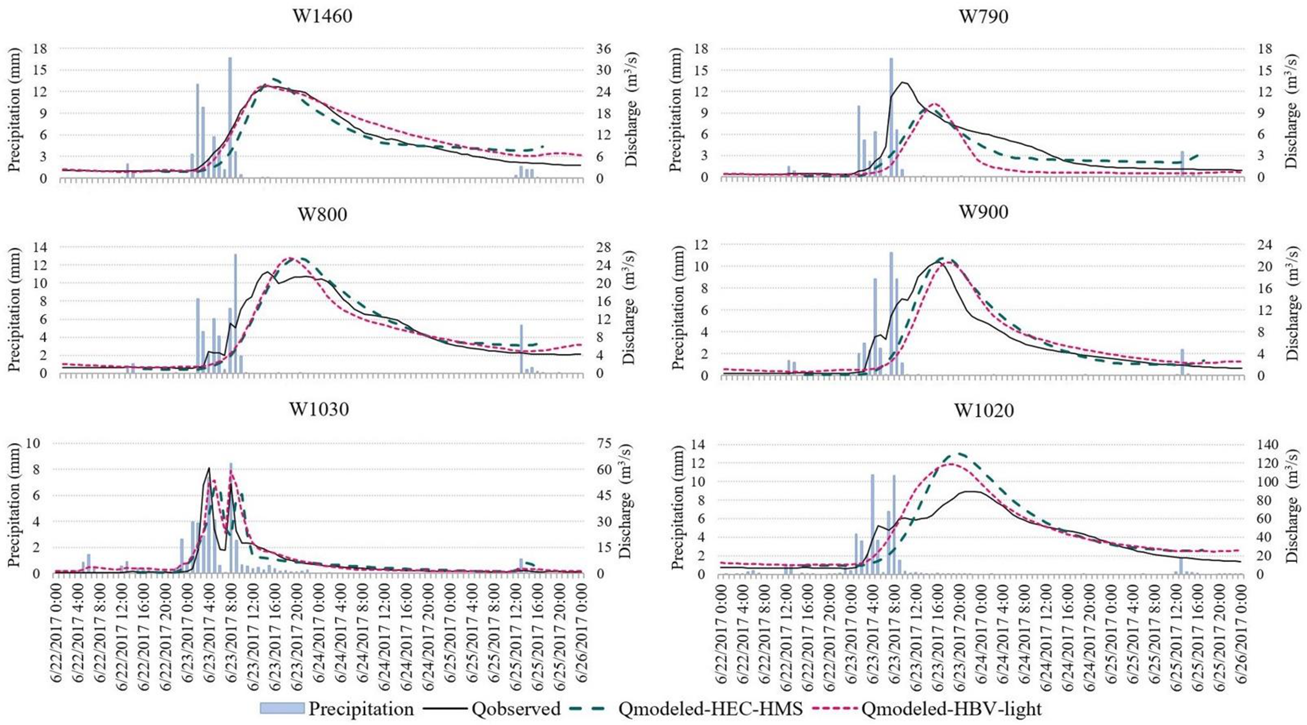
| Sub-Basin | A (km2) | Longest Flow Path (km) | Slope of Longest Flow Path (m/m) | Flow Gauging Station at Exit |
|---|---|---|---|---|
| W1460 | 161.6319 | 30.490527 | 0.007277 | 02HC047 |
| W790 | 63.2952 | 15.446972 | 0.007888 | 02HC023 |
| W800 | 192.4848 | 53.400175 | 0.003251 | 02HC009 |
| W900 | 140.3595 | 27.587806 | 0.004841 | 02HC031 |
| W1030 | 60.246 | 31.909755 | 0.004202 | 02HC027 |
| W1020 | 241.1919 | 76.009458 | 0.002489 | 02HC003 |
| W1180 | 29.8854 | 19.110794 | 0.004919 | - |
| No | Event Start | Event End | Modeled Period (h) | Season | Sub-Basins | 5-Day Antecedent Moisture Conditions (AMC) (mm) | AMC Type | Total Precipitation (mm) | Max Precipitation Intensity (mm/h) | Observed Peak Discharge (m3/s) | Comments | ||
|---|---|---|---|---|---|---|---|---|---|---|---|---|---|
| 1 | 28 May 2013 at 4:00 | 30 May 2013 at 20:00 | 64 | Growing | W1460 | 4.6 | I | 36.6 | 15.1 | 6.5 | High- intensity event | ||
| W790 | 3.7 | I | 36.4 | 19.0 | 3.2 | ||||||||
| W800 | 3.5 | I | 31.9 | 10.7 | 15.7 | ||||||||
| W900 | 2.9 | I | 55.8 | 25.2 | 62.1 | ||||||||
| W1030 | 2.1 | I | 47.8 | 24.0 | 122.4 | ||||||||
| W1020 | 3.0 | I | 48.3 | 26.0 | 107.8 | ||||||||
| 2 | 3 July 2013 at 23:00 | 10 July 2013 at 23:00 | 168 | Growing | W1460 | 0.8 | I | 63.4 | 10.0 | 6.5 | High- intensity event | ||
| W790 | 0 | I | 82.0 | 25.2 | 19.3 | ||||||||
| W800 | 0.2 | I | 81.6 | 17.9 | 69.9 | ||||||||
| W900 | 0.1 | I | 77.2 | 25.2 | 81.6 | ||||||||
| W1030 | 0 | I | 107.3 | 30.3 | 201.7 | ||||||||
| W1020 | 0 | I | 106.7 | 26.0 | 268.2 | ||||||||
| 3 | 7 April 2013 at 5:00 | 15 April 2013 at 23:00 | 210 | Dormant | W1460 | 0.9 | I | 74.2 | 4.2 | 9.0 | 11.0 | 10.5 | 2 peaks |
| W790 | 0.5 | I | 73.6 | 3.2 | 5.4 | 6.1 | 8.2 | ||||||
| W800 | 0.2 | I | 67.1 | 3.7 | 8.1 | 17.1 | 21.6 | ||||||
| W900 | 0.5 | I | 66.9 | 3.9 | 8.8 | 27.8 | 41.6 | ||||||
| W1030 | 0.2 | I | 44.7 | 2.4 | 3.5 | 17.8 | 14.2 | ||||||
| W1020 | 0.2 | I | 60.6 | 3.3 | 4.7 | 84.2 | 121.3 | ||||||
| 4 | 30 April 2017 at 5:00 | 7 May 2017 at 22:00 | 185 | Growing | W1460 | 10.3 | I | 84.1 | 3.9 | 3.2 | 6.1 | 11.8 | 2 peaks |
| W790 | 10.1 | I | 82.0 | 4.7 | 2.6 | 5.4 | 8.2 | ||||||
| W800 | 5.5 | I | 91.4 | 7.7 | 2.6 | 22.6 | 28.4 | ||||||
| W900 | 11.3 | I | 91.2 | 5.5 | 3.0 | 39.6 | 39.4 | ||||||
| W1030 | 11.2 | I | 89.9 | 4.1 | 4.8 | 24.8 | 15.0 | ||||||
| W1020 | 8.2 | I | 86.9 | 4.6 | 2.6 | 90.2 | 101.5 | ||||||
| 5 | 26 June 2010 at 7:00 | 30 June 2010 at 12:00 | 101 | Growing | W1460 | 56.7 | III | 35.3 | 7.8 | 6.6 | Normal to wet AMC at agricultural lands | ||
| W790 | 46.5 | II | 38.3 | 7.0 | 4.0 | ||||||||
| W800 | 46.0 | II | 30.9 | 4.9 | 7.6 | ||||||||
| W900 | 38.2 | II | 35.3 | 7.9 | 22.5 | ||||||||
| W1030 | 27.0 | I | 43.8 | 24.1 | 88.4 | ||||||||
| W1020 | 37.8 | II → I | 41.7 | 12.2 | 92.7 | ||||||||
| 6 | 22 June 2017 at 15:00 | 25 June 2017 at 17:00 | 74 | Growing | W1460 | 57.9 | III | 65.2 | 16.6 | 25.5 | Normal to wet AMC at agricultural lands | ||
| W790 | 56.3 | III → II | 54.5 | 16.6 | 13.3 | ||||||||
| W800 | 45.5 | II | 54.8 | 13.2 | 22.4 | ||||||||
| W900 | 35.2 | I → II | 42.6 | 11.2 | 20.7 | ||||||||
| W1030 | 33.8 | I | 44.9 | 8.4 | 61.0 | ||||||||
| W1020 | 38.9 | II → I | 48.4 | 10.7 | 89.4 | ||||||||
| Event | Δt (h) = Time of Observed Peak Q − Time of Max P | |||||
|---|---|---|---|---|---|---|
| W1460 | W790 | W800 | W900 | W1030 | W1020 | |
| 28–30 May 2013 | 18 | 10 | 6 | 10 | 2 | 14 |
| 3–10 July 2013 | 14 | 11 | 13 | 11 | 3 | 15 |
| 7–15 April 2013 (1st and 2nd peak) | 31 | 29 | 34 | 32 | 23 | 29 |
| 13 | 10 | 13 | 10 | 2 | 12 | |
| 30 April–7 May 2017 (1st and 2nd peak) | 13 | 14 | 18 | 28 | 1 | 13 |
| 27 | 28 | 29 | 13 | 15 | 25 | |
| 26–30 June 2010 | 17 | 11 | 5 | 13 | 1 | 2 |
| 22–25 June 2017 | 7 | 2 | 6 | 9 | −4 | 16 |
| Sub-Basin | Curve Number (CN) | % Total Imperviousness | % (Urban Settlement and Roads) | ||
|---|---|---|---|---|---|
| Weighted CNII (Normal Conditions) | CNI (Dry Conditions) | ||||
| W1460 | 59 | 38 | 8 | 10.5 | 0.637 |
| W790 | 80 | 63 | 10 | 13.1 | 0.6214 |
| W800 | 79 | 61 | 19 | 25.8 | 0.5452 |
| W900 | 81 | 64 | 16 | 23.1 | 0.5614 |
| W1030 | 91 | 81 | 73 | 97.7 | 0.1138 |
| W1020 | 85 | 70 | 42 | 54.9 | 0.3706 |
| W1180 | 89 | 77 | 73 | 99.5 | 0.103 |
| Author | Formula | Notes | References |
|---|---|---|---|
| Simas–Hawkins | Data of 168 basins in USA (0.001–14 km2) | [47,48] | |
| Johnstone–Cross | Data of 19 rural basins in USA (A = 64.8–4206.1 km2) | [49] | |
| Williams | Specially recommended to rural basins (A < 137 km2) | [50] | |
| Carter | Data of an urban basin in USA (A < 20.72 km2, S < 0.005) | [51] |
| Channel | Length (km) | Slope (m/m) | Muskingum X | Routed to Exit of Sub-Basin |
|---|---|---|---|---|
| R1580 | 75.522179 | 0.001905 | 0.3 | W1020 |
| R1590 | 51.146611 | 0.00185 | 0.3 | W1020 |
| R1600 | 19.12083 | 0.001358 | 0.425 | W1020 |
| R1610 | 24.819795 | 0.00226 | 0.25 | W1020 |
| R1620 | 7.358818 | 0.002319 | 0.45 | W1180 |
| R590 | 12.12955 | 0.003117 | 0.45 | W1180 |
| No | Warm-Up Start Date/Time | Warm-Up End Date/Time | Simulation Start Date/Time | Simulation End Date/Time |
|---|---|---|---|---|
| 1 | 28 May 2012 00:00 | 27 May 2013 23:00 | 28 May 2013 00:00 | 31 May 2013 00:00 |
| 2 | 04 July 2012 00:00 | 03 July 2013 23:00 | 04 July 2013 00:00 | 11 July 2013 00:00 |
| 3 | 07 April 2012 00:00 | 06 April 2013 23:00 | 07 April 2013 00:00 | 16 April 2013 00:00 |
| 4 | 30 April 2016 00:00 | 29 April 2017 23:00 | 30 April 2017 00:00 | 08 May 2017 00:00 |
| 5 | 26 June 2009 00:00 | 25 June 2010 23:00 | 26 June 2010 00:00 | 01 July 2010 00:00 |
| 6 | 22 June 2016 00:00 | 21 June 2017 23:00 | 22 June 2017 00:00 | 26 June 2017 00:00 |
| Sub-Basin | % Forests/Wetlands | % Croplands | % Urban |
|---|---|---|---|
| W1460 | 49.8 | 39.7 | 10.5 |
| W790 | 18.7 | 68.2 | 13.1 |
| W800 | 21.4 | 52.8 | 25.8 |
| W900 | 7.8 | 69.1 | 23.1 |
| W1030 | 0.2 | 2.1 | 97.7 |
| W1020 | 9.7 | 35.4 | 54.9 |
| Outlet of Sub-Basin | Tc (h) | R (h) | CN (I) | % Impervious | Initial Discharge per Area (m3/s/km2) | Recession Constant | Ratio to Peak | 28–30 May 2013 | 4–10 July 2013 | |
|---|---|---|---|---|---|---|---|---|---|---|
| Nash-Sutcliffe Efficiency (NSE) | NSE | |||||||||
| W1460 | 14.07 | 0.65 | 26.13 | 38 | 11 | 0.005 | 0.8 | 0.475 | 0.604 | 0.919 |
| W790 | 8.67 | 0.65 | 16.09 | 63 | 12 | 0.0035 | 0.8 | 0.1 | 0.569 | 0.858 |
| W800 | 14.15 | 0.5 | 14.15 | 61 | 14 | 0.003 | 0.8 | 0.3 | 0.624 | 0.858 |
| W900 | 11.77 | 0.525 | 13.01 | 70 | 42 | 0.001 | 0.8 | 0.1 | 0.774 | 0.781 |
| W1030 | 4.03 | 0.125 | 0.58 | 73 | 66 | 0.012 | 0.3 | 0.1 | 0.843 | 0.765 |
| W1020 | 18.04 | 0.35 | 9.72 | 63 | 38 | 0.01 | 0.8 | 0.025 | 0.713 | 0.897 |
| W1460 | W790 | W800 | W900 | W1030 | W1020 | ||
| TT (°C) | −0.5 | −0.5 | −0.5 | −0.5 | 0 | 0 | |
| CFMAX (mm/h °C) | 0.15 | 0.15 | 0.15 | 0.15 | 0.15 | 0.15 | |
| SP | 1 | 1 | 1 | 1 | 1 | 1 | |
| SFCF | 0.7 | 0.7 | 0.9 | 0.9 | 1 | 1 | |
| CFR | 0.05 | 0.05 | 0.05 | 0.05 | 0.05 | 0.05 | |
| CWH | 0.1 | 0.1 | 0.1 | 0.1 | 0.1 | 0.1 | |
| Forests and Wetlands | FC (mm) | 495 | 495 | 495 | 120 | 120 | 115 |
| LP | 0.1 | 0.1 | 0.1 | 0.75 | 0.75 | 0.775 | |
| BETA | 2.75 | 2.95 | 3.55 | 1.25 | 1 | 2.15 | |
| Croplands | FC (mm) | 490 | 490 | 490 | 100 | 80 | 95 |
| LP | 0.105 | 0.105 | 0.105 | 0.775 | 0.8 | 0.8 | |
| BETA | 3.15 | 3.75 | 3.95 | 1.35 | 1.05 | 2.25 | |
| Urban | FC (mm) | 90 | 85 | 65 | 55 | 40 | 50 |
| LP | 0.4 | 0.85 | 0.2 | 0.9 | 1 | 0.825 | |
| BETA | 3.45 | 3.95 | 4.75 | 2.5 | 2 | 2.275 | |
| PERC (mm/h) | 0.3 | 0.325 | 0.215 | 0.25 | 0.05 | 0.2 | |
| UZL (mm) | 9.5 | 5.5 | 1.45 | 1.75 | 2 | 12.5 | |
| K0 (1/h) | 0.3 | 0.135 | 0.1 | 0.1 | 0.3 | 0.25 | |
| K1 (1/h) | 0.01 | 0.0145 | 0.001 | 0.0015 | 0.165 | 0.001 | |
| K2 (1/h) | 0.004 | 0.0035 | 0.015 | 0.045 | 0.04 | 0.0015 | |
| MAXBAS (h) | 22 | 16 | 15 | 15 | 5 | 16 | |
| 28–30 May 2013 NSE | 0.8378 | 0.8673 | 0.6331 | 0.8334 | 0.8320 | 0.7096 | |
| 4–10 July 2013 NSE | 0.8101 | 0.7893 | 0.7580 | 0.8157 | 0.9014 | 0.9086 | |
| No | R1580 | R1590 | R1600 | R1610 | Outlet of W1020 | Simulated Peak Time Compared to Observed (h) | NSE | |||||||||
|---|---|---|---|---|---|---|---|---|---|---|---|---|---|---|---|---|
| K (h) | Peak Inflow (m3/s) | Peak Outflow (m3/s) | K (h) | Peak Inflow (m3/s) | Peak Outflow (m3/s) | K (h) | Peak Inflow (m3/s) | Peak Outflow (m3/s) | K (h) | Peak Inflow (m3/s) | Peak Outflow (m3/s) | Qmax Modeled | Qmax Observed | |||
| i | 5 | 5.7 | 5.6 | 5 | 14.8 | 13.8 | 1.1 | 42 | 41.9 | 6 | 59 | 54.3 | 255.2 | 268.2 | 0 | 0.860 |
| ii | 4 | 5.6 | 5 | 13.8 | 1.1 | 41.9 | 6 | 54.3 | 255.5 | 0 | 0.861 | |||||
| iii | 3 | 5.7 | 5 | 13.8 | 1.1 | 41.9 | 6 | 54.3 | 255.7 | 0 | 0.861 | |||||
| iv | 2.2 | 5.7 | 5 | 13.8 | 1.1 | 41.9 | 6 | 54.3 | 255.8 | 0 | 0.862 | |||||
| v | 5 | 5.6 | 4 | 14.1 | 1.1 | 41.9 | 6 | 54.3 | 255.1 | 0 | 0.863 | |||||
| vi | 5 | 5.6 | 3 | 14.4 | 1.1 | 41.9 | 6 | 54.3 | 254.6 | 0 | 0.866 | |||||
| vii | 5 | 5.6 | 2.2 | 14.5 | 1.1 | 41.9 | 6 | 54.3 | 254.1 | 0 | 0.869 | |||||
| viii | 5 | 5.6 | 5 | 13.8 | 1 | 42 | 6 | 54.3 | 255.1 | 0 | 0.861 | |||||
| ix | 5 | 5.6 | 5 | 13.8 | 1.1 | 41.9 | 5 | 55.5 | 258.3 | 0 | 0.867 | |||||
| x | 5 | 5.6 | 5 | 13.8 | 1.1 | 41.9 | 4 | 56.6 | 260 | 0 | 0.875 | |||||
| xi | 5 | 5.6 | 5 | 13.8 | 1.1 | 41.9 | 3 | 57.6 | 260.1 | 0 | 0.883 | |||||
| xii | 5 | 5.6 | 5 | 13.8 | 1.1 | 41.9 | 2 | 58.3 | 259.5 | −1 | 0.893 | |||||
| xiii | 4.5 | 5.6 | 3 | 14.4 | 1.1 | 41.9 | 2 | 58.3 | 259.8 | −1 | 0.897 | |||||
| Outlet of Sub-Basin | Tc (h) | R (h) | CN (I) | % Impervious | Initial Discharge per Area (m3/sec/km2) | Recession Constant | Ratio to Peak | 7–15 April 2013 | 30 April–7 May 2017 | |
|---|---|---|---|---|---|---|---|---|---|---|
| NSE | NSE | |||||||||
| W1460 | 14.07 | 0.7 | 32.83 | 38 | 24 | 0.012 | 0.8 | 0.475 | 0.647 | 0.858 |
| W790 | 8.67 | 0.65 | 16.09 | 63 | 22 | 0.0035 | 0.8 | 0.1 | 0.696 | 0.924 |
| W800 | 14.15 | 0.5 | 14.15 | 61 | 27 | 0.003 | 0.8 | 0.3 | 0.682 | 0.818 |
| W900 | 11.77 | 0.525 | 13.01 | 64 | 55 | 0.003 | 0.8 | 0.1 | 0.646 | 0.935 |
| W1030 | 4.03 | 0.175 | 0.85 | 65 | 36.5 | 0.002 | 0.3 | 0.275 | 0.611 | 0.516 |
| W1020 | 18.04 | 0.375 | 10.83 | 70 | 38 | 0.01 | 0.8 | 0.025 | 0.767 | 0.714 |
| W1460 | W790 | W800 | W900 | W1030 | W1020 | ||
| TT (°C) | −0.5 | −0.5 | −0.5 | −0.5 | 0 | 0 | |
| CFMAX (mm/h °C) | 0.15 | 0.15 | 0.15 | 0.15 | 0.15 | 0.15 | |
| SP | 1 | 1 | 1 | 1 | 1 | 1 | |
| SFCF | 0.7 | 0.7 | 0.9 | 0.9 | 1 | 1 | |
| CFR | 0.05 | 0.05 | 0.05 | 0.05 | 0.05 | 0.05 | |
| CWH | 0.1 | 0.1 | 0.1 | 0.1 | 0.1 | 0.1 | |
| Forests and Wetlands | FC (mm) | 495 | 495 | 495 | 120 | 120 | 100 |
| LP | 0.1 | 0.1 | 0.1 | 0.4 | 0.45 | 0.7 | |
| BETA | 1 | 1 | 1.05 | 3.65 | 1 | 3.5 | |
| Croplands | FC (mm) | 490 | 485 | 420 | 75 | 100 | 60 |
| LP | 0.105 | 0.225 | 0.3 | 0.45 | 0.5 | 0.75 | |
| BETA | 2.75 | 1.15 | 2.05 | 3.75 | 1.05 | 3.95 | |
| Urban | FC (mm) | 90 | 70 | 95 | 50 | 90 | 40 |
| LP | 0.4 | 0.8 | 0.45 | 0.7 | 1 | 0.775 | |
| BETA | 3.45 | 4.45 | 4.15 | 4 | 1.205 | 4.05 | |
| PERC (mm/h) | 1.2 | 1.25 | 1 | 0.55 | 0.1 | 0.6 | |
| UZL (mm) | 3 | 2 | 2 | 1.15 | 1.5 | 4 | |
| K0 (1/h) | 0.07 | 0.1 | 0.1 | 0.125 | 0.05 | 0.015 | |
| K1 (1/h) | 0.001 | 0.02 | 0.02 | 0.001 | 0.0185 | 0.095 | |
| K2 (1/h) | 0.0155 | 0.04 | 0.0315 | 0.035 | 0.025 | 0.0025 | |
| MAXBAS (h) | 11 | 12 | 17 | 14 | 1 | 12 | |
| 7–15 April 2013 NSE | 0.6855 | 0.7049 | 0.8619 | 0.8646 | 0.7151 | 0.8318 | |
| 30 April–7 May 2017 NSE | 0.9024 | 0.7025 | 0.7848 | 0.9212 | 0.6011 | 0.9018 | |
| Outlet of Sub-Basin | Tc (h) | R (h) | CN (III) or CN (II) or CN (I) | % Impervious | Initial Discharge per Area (m3/s/km2) | Recession Constant | Ratio to Peak | 26–30 June 2010 | 22–25 June 2017 | |
|---|---|---|---|---|---|---|---|---|---|---|
| NSE | NSE | |||||||||
| W1460 | 9.26 | 0.65 | 17.20 | 70 | 6.5 | 0.0125 | 0.8 | 0.35 | 0.810 | 0.897 |
| W790 | 8.08 | 0.575 | 10.94 | 68 | 12 | 0.001 | 0.8 | 0.275 | 0.570 | 0.613 |
| W800 | 14.15 | 0.575 | 19.14 | 71 | 16 | 0.005 | 0.8 | 0.275 | 0.722 | 0.869 |
| W900 | 11.77 | 0.525 | 13.01 | 77 | 16 | 0.0005 | 0.8 | 0.1 | 0.795 | 0.768 |
| W1030 | 2.82 | 0.15 | 0.50 | 61 | 51 | 0.0005 | 0.3 | 0.2 | 0.734 | 0.404 |
| W1020 | 18.04 | 0.425 | 13.34 | 66.5 | 33.5 | 0.0275 | 0.8 | 0.15 | 0.481 | 0.461 |
| W1460 | W790 | W800 | W900 | W1030 | W1020 | ||
| TT (°C) | −0.5 | −0.5 | −0.5 | −0.5 | 0 | 0 | |
| CFMAX (mm/h °C) | 0.15 | 0.15 | 0.15 | 0.15 | 0.15 | 0.15 | |
| SP | 1 | 1 | 1 | 1 | 1 | 1 | |
| SFCF | 0.7 | 0.7 | 0.9 | 0.9 | 1 | 1 | |
| CFR | 0.05 | 0.05 | 0.05 | 0.05 | 0.05 | 0.05 | |
| CWH | 0.1 | 0.1 | 0.1 | 0.1 | 0.1 | 0.1 | |
| Forests and Wetlands | FC (mm) | 425 | 495 | 495 | 175 | 120 | 110 |
| LP | 0.1 | 0.1 | 0.1 | 0.1 | 0.75 | 0.6 | |
| BETA | 3.95 | 1.55 | 1.65 | 2.25 | 1 | 1.05 | |
| Croplands | FC (mm) | 390 | 490 | 490 | 150 | 80 | 100 |
| LP | 0.105 | 0.105 | 0.105 | 0.115 | 0.8 | 0.75 | |
| BETA | 4.05 | 3.45 | 2.95 | 2.45 | 1.05 | 1.45 | |
| Urban | FC (mm) | 90 | 85 | 90 | 125 | 40 | 85 |
| LP | 0.4 | 0.95 | 0.8 | 0.65 | 1 | 0.95 | |
| BETA | 4.15 | 4.75 | 3.45 | 2.55 | 1.15 | 1.55 | |
| PERC (mm/h) | 1.25 | 0.115 | 0.6 | 0.4 | 0.15 | 0.4 | |
| UZL (mm) | 7.5 | 2.5 | 4.5 | 4 | 6.5 | 5 | |
| K0 (1/h) | 0.05 | 0.6 | 0.04 | 0.04 | 0.255 | 0.0015 | |
| K1 (1/h) | 0.02 | 0.095 | 0.06 | 0.075 | 0.115 | 0.0325 | |
| K2 (1/h) | 0.0325 | 0.0135 | 0.03 | 0.04 | 0.025 | 0.0075 | |
| MAXBAS (h) | 9 | 16 | 17 | 16 | 1 | 6 | |
| 26–30 June 2010 NSE | 0.7472 | 0.8022 | 0.7749 | 0.8268 | 0.9244 | 0.7021 | |
| 22–25 June 2017 NSE | 0.9453 | 0.4021 | 0.9045 | 0.7615 | 0.6536 | 0.7027 | |
| Event | Volume Error (%) due to HEC-HMS | Volume Error (%) due to HBV-Light | ||||||||||
|---|---|---|---|---|---|---|---|---|---|---|---|---|
| W1460 | W790 | W800 | W900 | W1030 | W1020 | W1460 | W790 | W800 | W900 | W1030 | W1020 | |
| 28–30 May 2013 | −19.63 | 11.23 | 3.93 | 21.21 | 30.85 | 20.70 | 18.77 | 11.34 | 3.22 | 27.59 | −2.09 | 9.96 |
| 4–10 July 2013 | −3.15 | 20.25 | −14.27 | 31.69 | 5.00 | 5.45 | −10.55 | −22.85 | −38.36 | −2.69 | −22.90 | −16.17 |
| 7–15 April 2013 | −21.24 | −13.85 | −16.64 | −11.94 | −27.56 | −7.22 | 6.33 | 21.75 | 8.52 | −0.58 | −19.68 | 2.18 |
| 30 April–7 May 2017 | 12.61 | 5.56 | 11.29 | 4.14 | 24.27 | 14.07 | −4.82 | −20.75 | −1.86 | 8.83 | 44.75 | −0.14 |
| 26–30 June 2010 | −7.88 | −0.51 | −3.78 | −19.85 | 30.50 | −25.01 | 5.93 | 19.63 | −1.50 | 31.50 | −3.95 | −12.66 |
| 22–25 June 2017 | −3.21 | −17.91 | 0.55 | −0.24 | 12.34 | 15.70 | 11.29 | −47.73 | −3.19 | 3.98 | 31.07 | 19.24 |
Publisher’s Note: MDPI stays neutral with regard to jurisdictional claims in published maps and institutional affiliations. |
© 2021 by the authors. Licensee MDPI, Basel, Switzerland. This article is an open access article distributed under the terms and conditions of the Creative Commons Attribution (CC BY) license (https://creativecommons.org/licenses/by/4.0/).
Share and Cite
Sarchani, S.; Awol, F.S.; Tsanis, I. Hydrological Analysis of Extreme Rain Events in a Medium-Sized Basin. Appl. Sci. 2021, 11, 4901. https://doi.org/10.3390/app11114901
Sarchani S, Awol FS, Tsanis I. Hydrological Analysis of Extreme Rain Events in a Medium-Sized Basin. Applied Sciences. 2021; 11(11):4901. https://doi.org/10.3390/app11114901
Chicago/Turabian StyleSarchani, Sofia, Frezer Seid Awol, and Ioannis Tsanis. 2021. "Hydrological Analysis of Extreme Rain Events in a Medium-Sized Basin" Applied Sciences 11, no. 11: 4901. https://doi.org/10.3390/app11114901
APA StyleSarchani, S., Awol, F. S., & Tsanis, I. (2021). Hydrological Analysis of Extreme Rain Events in a Medium-Sized Basin. Applied Sciences, 11(11), 4901. https://doi.org/10.3390/app11114901






